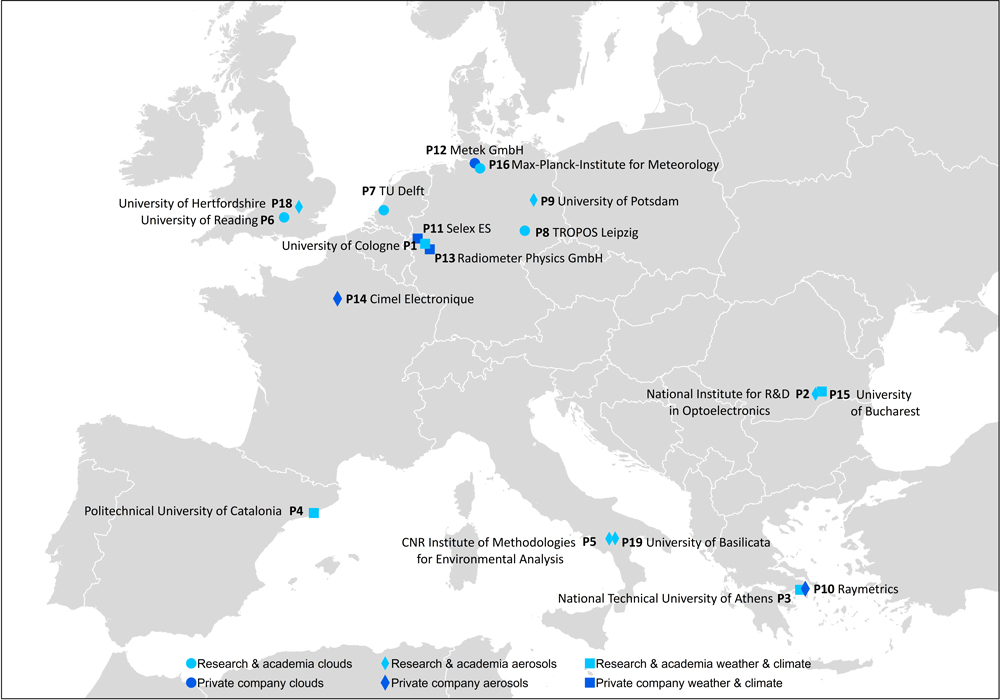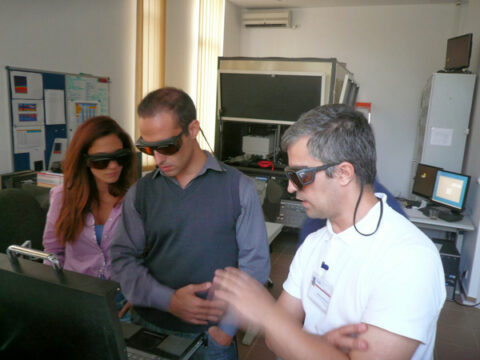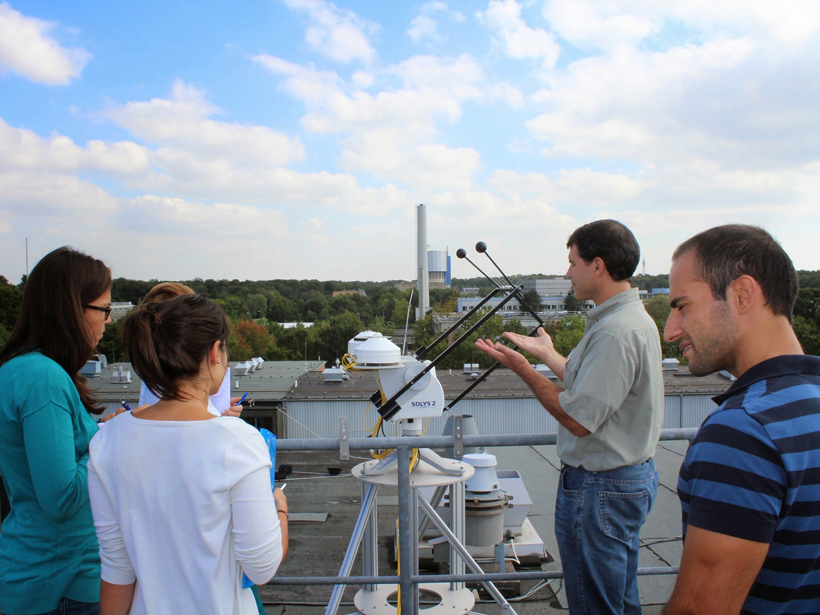Aerosol-cloud interaction is recognized as the single largest uncertainty in today’s climate models. In the fifth report of the Intergovernmental Panel on Climate Change, scientists state with high confidence that aerosols and their interactions with clouds have offset a substantial portion of global average warming due to the effects of well-mixed greenhouse gases. They continue to contribute the largest uncertainty to the total estimate of climate warming. As such, they are a very important component to the planetary boundary layer, the layer of Earth’s atmosphere directly influenced by its contact with Earth’s surface.
The European Commission, the European Union’s executive body, now funds a training network that combines multiple disciplines to exploit innovative atmospheric remote sensing techniques that advance our understanding of aerosol-cloud interaction. The network, called the Initial Training for Atmospheric Remote Sensing (ITaRS), is a 4-year project (2012–2016) providing support for 16 Ph.D. students and young postdocs who are employed at one of nine European research institutions.
ITaRS Framework and Goals
ITaRS comprises 10 associated partners—five of them manufacturers of meteorological instruments, five of them academic research institutions. ITaRS participants work at these partners’ facilities, focusing on applying ground-based remote sensing instrumentation to improve our understanding of aerosols, clouds, and their interaction in both climate and weather. Figure 1 shows the geographical distribution of the network.

Funding for the positions filled by ITaRS participants is provided through the European Commission’s Marie Skłodowska-Curie fellowships, grants available to researchers regardless of their nationality and field of research. ITaRS is a subset of the Marie Skłodowska-Curie program’s popular Initial Training Networks (ITNs). ITNs aim to improve career perspectives of young researchers by preparing them for a career in both the public and private sectors. ITNs offer young researchers prime appointments at research institutions in an effort to make scientific careers more attractive and eliminate cultural and other barriers to career mobility.
Two thirds of ITaRS fellows are from European Union member states, but fellows also originate from Russia (two), China (one), Pakistan (one), and the United States (one).
A Pan-European Training Program
The program is the first step to developing sustainable pan-European Ph.D. training in the research community that focuses on aerosols and clouds.
ITaRS is the first step to developing sustainable pan-European Ph.D. training in the research community that focuses on aerosols and clouds. But how does life in a graduate school work if the students are spread all over Europe?
For the past 3 years, the ITaRS training program has included two summer schools that bring together all fellows. The National Institute for Research and Development in Optoelectronics in Bucharest, Romania, hosted the first summer school, Aerosol Remote Sensing, Processes & Applications. Students presented on topics investigated using various ground-based remote sensing instruments (e.g., Raman lidar, Sun photometers), such as evolution of the planetary boundary layer height and determination of aerosol optical properties.
In addition, a field campaign performed at the summer school provided an interesting data set on surface aerosol composition from an aerosol mass spectrometer (AMS) and vertical structure from a multiwavelength Raman lidar. Fellows also produced semiautomated microphysical retrievals for biomass-burning aerosol cases captured by lidar and then evaluated the results using the AMS and Sun photometer retrievals [Samaras et al., 2015]. They found that observations reflected only a small portion of phenomena predicted by mathematics.
The second summer school on Remote Sensing of Clouds and Precipitation: Observation and Processes took place on 8−17 September 2014 at the Research Center in Jülich, Germany. Participants benefited from hands-on training with instruments from the Jülich Observatory for Cloud Evolution (JOYCE) site, including a microwave radiometer, scanning cloud radar, micro rain radar, wind lidar, sonic detecting and ranging, and an infrared spectrometer. Participants also investigated polarimetric twin radars in Bonn and Jülich. The summer school was such a success that the U.S. Atmospheric Radiation Measurement program decided to follow the ITaRS format for a follow-on summer school in 2015.

Two ITaRS fellows, Robert Banks and Lev Labzovsky, attended the 2014 Aerosols, Clouds, and Trace Gases Research Infrastructure (ACTRIS) Winter School on Advanced Analysis of Atmospheric Processes and Feedbacks and Atmosphere-Biosphere Interactions, hosted by the Division of Atmospheric Sciences of the University of Helsinki. The intensive 2-week course took place from 10 to 21 March 2014 at the Hyytiälä Forestry Field Station in southern Finland. Relevant topics to the fellows included remote sensing of vertical aerosol distribution, clouds and aerosol quality-controlled observations, and the synergies between lidar and Sun photometers.
Fellows also engage in network-wide workshops where they are trained in instrumentation, atmospheric physics, and algorithms for the interpretation of the measurements. Perhaps most helpful for broadening applied skill sets, fellows also visit other ITaRS partners for 2- to 4-week training sessions (secondments), during which they get hands-on experience in specific techniques applicable to their individual Ph.D.’s.
Between meetings, weekly e-seminars promote communication within the network.
Research Examples
Network events have also led to discussions between instrument experts and scientists from the aerosol and cloud community and helped to refine fellows’ Ph.D. topics. In particular, the dialogue with the industrial partners has been useful, leading to better exploitation and development of instrumentation.
The dialogue with industrial partners has been useful, leading to better exploitation and development of instrumentation.
One example of such collaboration occurred when the Leibniz Institute for Tropospheric Research and private industrial partner Meteorologische Messtechnik GmbH performed a series of field measurements. This led the ITaRS fellow at the Leibniz Institute for Tropospheric Research to conduct a study that improved the use of innovative polarimetric techniques for cloud radar.
Another example is the recent work by Myagkov et al. [2015], which considers the influence of antenna amplitude and phase patterns on polarimetric measurements taken with certain cloud radars operating in linear depolarization mode—a method that helps determine the shape and orientation of ice crystals. They discovered a correction algorithm for the linear depolarization ratio and co-cross-channel correlation coefficient, which can be used to better understand how ice crystals aggregate and form rime, the frozen water droplets that can sometimes coat snowflakes.
Participation in Field Campaigns
ITaRS fellows have participated in several international field campaigns to improve atmospheric research. In the summer of 2014, the From Hygroscopic Aerosols to Cloud Droplets (HygrA-CD) and Characterization of Aerosol mixtures of Dust and Marine origin (CHARADMExp) campaigns took place in Greece. Fellows, along with host scientists, are currently analyzing data from these campaigns.
For example, Banks et al. [2016] used lidar, radiosonde, and surface meteorological observations from HygrA-CD to evaluate how well phenomena within the planetary boundary layer are simulated within the popular Weather Research and Forecasting numerical weather prediction model. They found that planetary boundary layer schemes that diagnose turbulent mixing in adjacent and nonadjacent model levels (nonlocal closure) tended to reproduce values closest to the observations.
During fall 2014, several ITaRS fellows participated in the Analysis of the Composition of mixed-phase Clouds with Extended Polarization Techniques (ACCEPT) campaign in Cabauw, Netherlands, and presented results in Vienna at the General Assembly of the European Geosciences Union in April 2015. The main objective of ACCEPT was to analyze the composition of mixed-phase clouds with extended polarization techniques.
Outreach
The ITaRS network also facilitates scientific divulgation and outreach. At the first summer school in Bucharest, the fellows developed four short videos to help explain science to the general public. The program also hosted a debate with local university students on climate change at its first workshop in February 2013 as well as a science show for high school students in September 2013. Most recently, ITaRS fellows have begun enhancing Wikipedia articles involving topics in atmospheric remote sensing.
In addition, the ITaRS network hosted a booth at the Meteorological Technology World Expo 2015 in Brussels. At the booth, interested attendees met fellows, learned about the results of research projects, and discussed their future plans. Two ITaRS partners, Susanne Crewell and José Maria Baldasano, presented at the conference during a trade fair on Tuesday and Wednesday, respectively.
Future Plans
Being part of a nascent network of young applied scientists provides many rewards, says fellow Maria Barrera Verdejo: “The 16 ITaRS fellows are a really strong group; we grow together. We have many opportunities to go to conferences and to organize our own meetings, and I feel that we are lucky to have this position.”
Together, the ITaRS fellows will form a new generation of scientists that are able to close the gap between the specialized development of single instruments and atmospheric applications. The last year of funding by the European Commission is 2016; talk of ITaRS2 is ongoing.
More information is available at the ITaRS website.
Acknowledgments
The authors have received funding from the European Union Seventh Framework Programme (FP7/2007-2013): People, ITN Marie Curie Actions Programme (2012–2016) in the frame of ITaRS under grant agreement 289923.
References
Banks, R. F., J. Tiana-Alsina, J. M. Baldasano, F. Rocadenbosch, A. Papayannis, S. Solomos, and C. G. Tzanis (2016), Sensitivity of boundary layer variables to PBL schemes in the WRF model based on surface meteorological observations, lidar, and radiosondes during the HygrA-CD campaign, Atmos. Res., in press.
Myagkov, A., P. Seifert, U. Wandinger, M. Bauer-Pfundstein, and S. Y. Matrosov (2015), Effects of antenna patterns on cloud radar polarimetric measurements, J. Atmos. Oceanic Technol., 32, 1813–1828, doi:10.1175/JTECH-D-15-0045.1.
Samaras, S., D. Nicolae, C. Böckmann, J. Vasilescu, I. Binietoglou, L. Labzovskii, F. Toanca, and A. Papayannis (2015), Using Raman-lidar-based regularized microphysical retrievals and aerosol mass spectrometer measurements for the characterization of biomass burning aerosols, J. Comput. Phys., 299, 156–174, doi:10.1016/j.jcp.2015.06.045.
Author Information
Robert F. Banks, Environmental Modelling Laboratory, Polytechnic University of Catalonia, Barcelona, Spain, and Earth Sciences Department, Barcelona Supercomputing Center, Barcelona, Spain; email: [email protected]; Susanne Crewell and Sarah Henkel, Institute of Geophysics and Meteorology, University of Cologne, Cologne, Germany; and José M. Baldasano, Environmental Modelling Laboratory, Polytechnic University of Catalonia, Barcelona, Spain, and Earth Sciences Department, Barcelona Supercomputing Center, Barcelona, Spain
Citation: Banks, R. F., S. Crewell, S. Henkel, and J. M. Baldasano, Training network for young atmospheric researchers, Eos, 97, doi:10.1029/2016EO045899. Published on 16 February 2016.
Text © 2016. The authors. CC BY-NC 3.0
Except where otherwise noted, images are subject to copyright. Any reuse without express permission from the copyright owner is prohibited.

